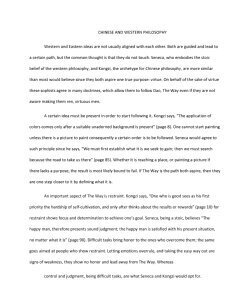CHINESE AND WESTERN PHILOSOPHY Western and Eastern ideas are not usually aligned with each other. Both are guided and lead to a certain path, but the common thought is that they do not touch. Seneca,
CHINESE AND WESTERN PHILOSOPHY Western and Eastern ideas are not usually aligned with each other. Both are guided and lead to a certain path, but the common thought is that they do not touch. Seneca,
CHINESE AND WESTERN PHILOSOPHY
Western and Eastern ideas are not usually aligned with each other. Both are guided and lead to a certain path, but the common thought is that they do not touch. Seneca, who embodies the stoic belief of the western philosophy, and Kongzi, the archetype for Chinese philosophy, are more similar than most would believe since they both aspire one true purpose: virtue. On behalf of the sake of virtue these sophists agree in many doctrines, which allow them to follow Dao, The Way even if they are not aware making them ren, virtuous men.
A certain idea must be present in order to start following it. Kongzi says, “The application of colors comes only after a suitable unadorned background is present” (page 8). One cannot start painting unless there is a picture to paint consequently a certain order is to be followed. Seneca would agree to such principle since he says, “We must first establish what it is we seek to gain; then we must search because the road to take us there” (page 85). Whether it is reaching a place, or painting a picture if there lacks a purpose, the result is most likely bound to fail. If The Way is the path both aspire, then they
